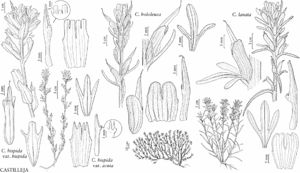Castilleja hispida var. acuta
in C. L. Hitchcock et al., Vasc. Pl. Pacif. N.W. 4: 309. 1959.
Leaves narrowly to broadly lanceolate, sometimes oblanceolate, 0–3(–5)-lobed, apex acute to acuminate. Bracts distally red to orange, sometimes crimson, scarlet, orange-red, or red-orange, lobes or proximal ones at least becoming paler and/or duller with age, orange ones becoming yellow, red ones sometimes becoming pale purple; lobes broadly linear to narrowly lanceolate, long, central lobe apex obtuse to rounded or truncate, sometimes emarginate, lateral ones acute to obtuse. Calyces 19–27 mm; lateral clefts 4.5–7 mm; lobes oblong, triangular, or linear, apex acute. Corollas 25–33 mm; abaxial lip 1–3 mm, 33% length of beak. 2n = 96.
Phenology: Flowering (Mar–)Apr–Sep.
Habitat: Sagebrush steppes, grassy slopes, dry open forests, ledges, talus.
Elevation: 500–2200 m.
Distribution
Idaho, Mont., Oreg., Wash.
Discussion
Variety acuta sporadically replaces var. hispida on the eastern slope of the Cascade Range and extends eastward from there to southwestern Montana and northeastern Oregon. Variety acuta hybridizes with Castilleja lutescens in Garfield County, Washington.
Selected References
None.
